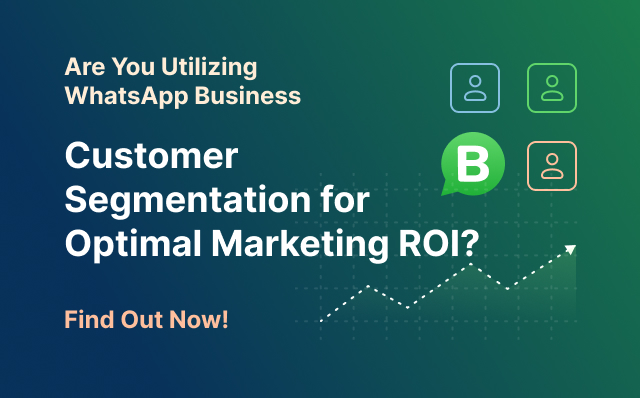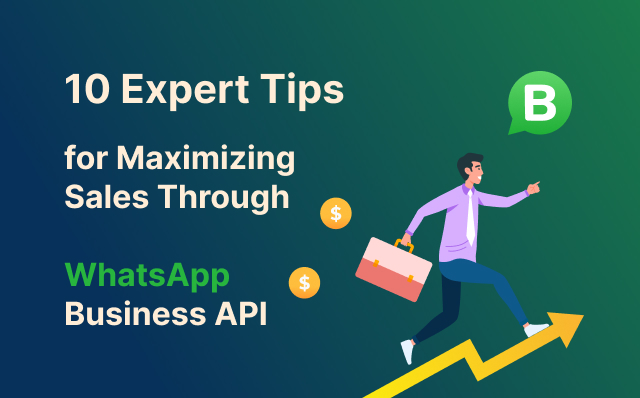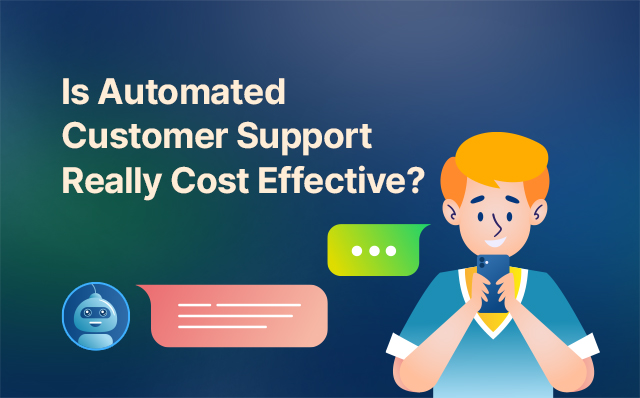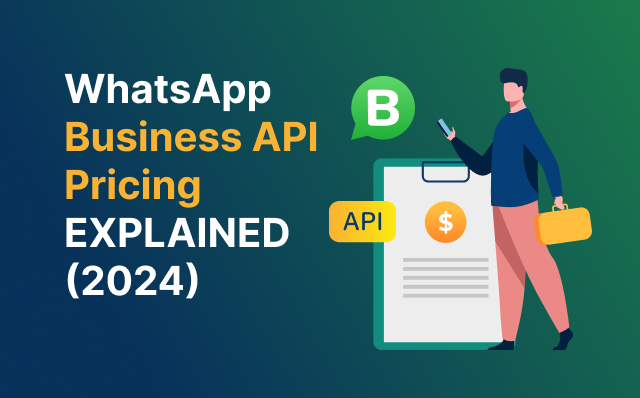Table of Contents
Personalization is essential for successful marketing, and WhatsApp provides a powerful platform for connecting with audiences on a personal level. To maximize ROI and reduce customer churn, businesses need to leverage WhatsApp effectively through segmentation. By breaking down your audience into smaller, targeted groups, you can craft messages that align with specific customer needs and preferences.
In this blog, we’ll explore how utilizing WhatsApp Business for customer segmentation can optimize your marketing ROI and why it’s an essential strategy for modern businesses. Whether your goal is to re-engage at-risk customers or boost engagement through tailored communication, this comprehensive guide provides valuable insights and practical steps to enhance your WhatsApp marketing efforts.
Understanding Customer Segmentation
Customer segmentation involves dividing a customer base into distinct groups based on various characteristics such as demographics, behavior, interests, and purchase history. By understanding these segments, businesses can tailor their marketing messages and offers to meet the specific needs and preferences of each group. This targeted approach not only improves customer engagement but also boosts conversion rates and ROI.
Why WhatsApp Business?
WhatsApp Business offers a unique platform for customer segmentation due to its widespread use, real-time communication capabilities, and rich feature set. With over 2 billion users worldwide, WhatsApp provides a direct and personal channel to reach customers. The app’s features, such as broadcast lists, automated messages, and labels, make it easier for businesses to segment and manage their customer interactions effectively.
Why Use WhatsApp for Segmentation?
WhatsApp is an ideal platform for customer segmentation due to its widespread use, real-time communication capabilities, and rich feature set. With over 2 billion users worldwide, WhatsApp provides a direct and personal channel for reaching customers. Its features, such as broadcast lists, labels, and automated messages, make it easy to manage and segment customer interactions effectively.
Benefits of Customer Segmentation with WhatsApp Business
1. Enhanced Personalization
Personalization is key to successful marketing. With WhatsApp Business, you can send personalized messages to different customer segments. For example, you can send exclusive offers to loyal customers, product recommendations based on past purchases, or reminders to customers who abandoned their carts. This level of personalization makes customers feel valued and understood, increasing their likelihood of making a purchase.
2. Improved Customer Engagement
Segmented messaging ensures that your communications are relevant to each group, leading to higher engagement rates. Customers are more likely to respond to messages that address their specific needs and interests. WhatsApp’s interactive features, such as quick replies and multimedia messages, further enhance engagement by making the communication process more dynamic and interactive.
3. Efficient Resource Allocation
By targeting specific segments, businesses can allocate their marketing resources more efficiently. Instead of sending generic messages to a broad audience, you can focus your efforts on high-value segments that are more likely to convert. This targeted approach reduces wasted spend and increases the efficiency of your marketing campaigns, ultimately improving ROI.
4. Real-Time Feedback and Insights
WhatsApp Business allows you to gather real-time feedback from your customers. By analyzing responses and engagement levels, you can gain valuable insights into customer preferences and behavior. This data can inform your segmentation strategy and help you refine your marketing efforts for even better results.
5. Strengthened Customer Relationships
Regular, personalized communication via WhatsApp helps build stronger relationships with your customers. When customers feel that a business understands and caters to their individual needs, their loyalty increases. Loyal customers are not only more likely to make repeat purchases but also to recommend your business to others, further boosting your ROI.
How to Implement Customer Segmentation with WhatsApp Business
Customer segmentation is a crucial strategy for maximizing the effectiveness of your marketing efforts on WhatsApp Business. By dividing your audience into distinct groups based on specific characteristics, you can tailor your messages to meet their individual needs, leading to higher engagement and conversions. Here’s a detailed guide on how to implement customer segmentation with WhatsApp Business:
Step 1: Collect and Analyze Customer Data
The foundation of effective customer segmentation is comprehensive data collection and analysis. This involves gathering detailed information about your customers to understand their behaviors, preferences, and needs.
- Demographic Information: Collect data on age, gender, location, occupation, and other demographic factors.
- Purchase History: Analyze past purchases to identify buying patterns and preferences.
- Browsing Behavior: Use website analytics to track how customers interact with your site, including pages visited, time spent, and items viewed.
- Feedback and Reviews: Gather customer feedback from surveys, reviews, and direct interactions to gain insights into their satisfaction and expectations.
Tools to Use:
- CRM Systems: Tools like Salesforce, HubSpot, or Zoho can help you manage and analyze customer data.
- Website Analytics: Google Analytics provides in-depth insights into browsing behavior.
- Social Media Insights: Platforms like Facebook Insights and Twitter Analytics offer valuable data on customer engagement and preferences.
Step 2: Define Your Segments
Once you have collected and analyzed the data, the next step is to define clear customer segments. These segments should reflect the diverse characteristics and behaviors of your customer base.
Common Segments:
- New Customers: First-time buyers or users who have recently interacted with your brand.
- Loyal Customers: Repeat buyers who consistently purchase from your business.
- High Spenders: Customers who spend significantly more than the average buyer.
- Inactive Customers: Individuals who haven’t made a purchase or interacted with your brand for a certain period.
Tips for Effective Segmentation:
- Use Detailed Criteria: The more detailed your segments, the more precise your targeting can be. Consider factors like purchasing frequency, average order value, and product categories.
- Combine Data Points: Create segments that combine multiple data points (e.g., high spenders who frequently purchase specific product categories).
Step 3: Utilize WhatsApp Business Features
WhatsApp Business offers several features that make it easier to manage and communicate with your customer segments effectively.
- Labels: Use labels to categorize your contacts into different segments. For example, you can label contacts as “New Customers,” “High Spenders,” etc. This helps in organizing your audience and sending targeted messages.
- Broadcast Lists: Create broadcast lists for each segment to send personalized messages to multiple recipients simultaneously without forming a group chat. This ensures privacy and maintains a personal touch.
- Automated Messages: Set up automated greetings and responses to ensure timely and relevant communication. For instance, send a welcome message to new customers or a thank-you note after a purchase.
- Quick Replies: Save and use pre-written responses for common queries. This not only saves time but also ensures consistency in communication.
Step 4: Craft Personalized Messages
Develop personalized messages for each segment to enhance relevance and engagement.
Tips for Crafting Effective Messages:
- Relevance: Ensure the content is tailored to the specific needs and preferences of each segment. For example, send special discounts to loyal customers or product recommendations based on past purchases.
- Value: Provide value in your messages, whether it’s through exclusive offers, useful information, or engaging content.
- Multimedia Elements: Use images, videos, and links to make your messages more engaging and informative. Visual content can significantly enhance the appeal and effectiveness of your messages.
Step 5: Monitor and Optimize
To ensure the success of your segmented campaigns, continuously monitor their performance and make necessary adjustments.
Key Metrics to Track:
- Open Rates: Measure how many recipients open your messages. High open rates indicate effective targeting and compelling subject lines.
- Response Rates: Track how many recipients respond to your messages. This metric helps gauge engagement levels.
- Conversion Rates: Monitor how many recipients take the desired action, such as making a purchase or signing up for a service.
Optimization Tips:
- Analyze Data: Use WhatsApp’s analytics tools to analyze the performance of your campaigns. Identify patterns and areas for improvement.
- A/B Testing: Test different message formats, content, and timing to see what works best for each segment.
- Feedback Loop: Continuously gather feedback from your customers to understand their preferences and improve your messaging strategy accordingly.
Conclusion: Unlocking the Power of Segmentation with WhatsApp Business
Customer segmentation is a powerful strategy that can significantly enhance your marketing efforts and ROI. By leveraging WhatsApp Business for customer segmentation, you can deliver personalized, relevant messages that resonate with your audience, foster stronger customer relationships, and drive higher conversions.
Key Takeaways:
- Personalized Communication: Tailoring messages to specific customer segments ensures that your communications are more relevant and engaging, which can lead to higher open and response rates.
- Efficient Resource Use: By focusing your marketing efforts on well-defined segments, you can allocate your resources more efficiently, reducing waste and improving the overall effectiveness of your campaigns.
- Enhanced Customer Insights: Regular analysis of segmented customer data provides deeper insights into customer behaviors and preferences, enabling continuous optimization of your marketing strategies.
- Stronger Relationships: Personalized interactions build trust and loyalty, leading to long-term customer relationships that can drive repeat business and positive word-of-mouth.
Immediate Actions:
- Start Small: If you’re new to customer segmentation, begin with a few basic segments and gradually refine them as you gather more data and insights.
- Leverage Technology: Utilize CRM systems, analytics tools, and WhatsApp Business features to automate and streamline your segmentation and communication processes.
- Monitor and Adapt: Continuously monitor the performance of your segmented campaigns, gather feedback, and be ready to adapt your strategies to changing customer needs and market trends.
Future Opportunities:
Looking ahead, the potential of customer segmentation on WhatsApp Business is immense. As you refine your segmentation strategies, consider exploring advanced techniques such as:
- Behavioral Segmentation: Dive deeper into customer behavior patterns to create highly specific segments that reflect not just demographics but also purchasing habits and engagement levels.
- Predictive Analytics: Use predictive analytics to anticipate customer needs and preferences, allowing for even more targeted and proactive marketing efforts.
- Integration with Other Channels: Combine WhatsApp Business segmentation with other marketing channels to create a cohesive, omnichannel marketing strategy that provides a seamless customer experience.
If you’re not yet utilizing customer segmentation on WhatsApp Business, now is the time to start. Unlock the potential of personalized marketing and watch your ROI soar. By embracing the power of segmentation, you can transform your marketing efforts, deliver exceptional customer experiences, and achieve your business goals more effectively.
In a competitive digital landscape, the businesses that stand out are those that understand and cater to the unique needs of their customers. WhatsApp Business, with its robust segmentation capabilities, offers a powerful tool to help you achieve this. Start your segmentation journey today and see the difference it makes in your marketing success.





